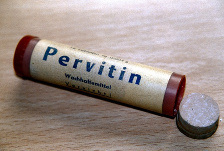Tom Stafford's Blog, page 51
June 23, 2013
What is it like being nerve gassed?
 I’ve just found an interesting article in the Journal of Pharmacy Practice that discusses the medical management of chemical weapons injuries.
I’ve just found an interesting article in the Journal of Pharmacy Practice that discusses the medical management of chemical weapons injuries.
It has a particularly attention-grabbing section that describes the effects of being nerve gassed. I’ve pasted it below, but as it was dense with medical jargon, I’ve added explanations in square brackets.
The nerve agents prevent the breakdown of [neurotransmitter] acetylcholine resulting in a cholinergic crisis. Muscarinic effects from nerve agents include miosis [constriction of the pupils of the eyes], bradycardia [slowed heartbeat], diarrhea [eww], nausea and vomiting, diaphoresis [excessive sweating], bronchial secretions [fluid in the lungs], and bronchial constriction [lung tightening]. A dimming of vision occurs with the miosis.
Nicotinic effects include tachycardia [fast heartbeat] and muscle twitching which progresses to muscle paralysis. The toxidrome [poisoning syndrome] depends of the route of absorption. When dermally absorbed [through the skin] muscle twitching occurs first. With inhalation exposure, breathing difficulties are seen first.
The onset of symptoms with inhalation exposure is within 5 minutes. With dermal exposure, it can last up to several hours. The seizures due to nerve agents may be from blocking [neurotransmitter] γ-aminobutyric acid (GABA).
The article also discusses other types of chemical weapons: blister agents, choking agents, incapacitating agents, riot control agents, blood agents, and toxic industrial chemicals. All of which sound very unpleasant.
However, ‘incapacitating agents’ can also mean substances that have psychotropic effects. These can be anything which drug the person to a state where they are less able to resist.
In theory, these could be anything, but the article particularly notes opioid-based gasses (think vaporised synthetic heroin – like the fenatyl derivative used in the 2002 Moscow theatre siege by Russian special forces) or the hallucinogenic drug BZ which has featured in many favourite conspiracy theories.
Link to locked article on chemical weapons medicine.


A taxonomy of ayahuasca hallucinations
 A wonderful list categorising hallucinations experienced by the Cashinahua people of Peru after drinking the hallucinogenic brew ayahuasca.
A wonderful list categorising hallucinations experienced by the Cashinahua people of Peru after drinking the hallucinogenic brew ayahuasca.
1. Brightly colored, large snakes
2. Jaguars and ocelots
3. Spirits, both of ayahuasca and others
4. Large trees, often falling trees
5. Lakes, frequently filled with anacondas and alligators
6. Cashinahua villages and those of other Indians
7. Traders and their goods
8. Gardens
It reported by the anthropologist Ken Kensinger in a chapter in the book Hallucinogens and Shamanism.
It reminded me of writer Jorge Luis Borges’ whimsical classification system for animals.


June 18, 2013
Is social psychology really in crisis?
My latest ‘behind the headlines’ column for The Conversation. Probably all old news for you wised-up mindhacks.com readers, but here you go:
The headlines
Disputed results a fresh blow for social psychology
The story
Controversy is simmering in the world of psychology research over claims that many famous effects reported in the literature aren’t reliable, or may even not exist at all.
The latest headlines follow the publication of experiments which failed to replicate a landmark study by Dutch psychologist Ap Dijksterhuis. These experiments are examples of what psychologists call “social priming”, which is a phenomenon where people who are exposed to ideas unconsciously incorporate them into their behaviour. So people who are reminded of old age are reported to walk slower, and people asked to think about university professors do better on a trivial pursuit knowledge test.
What they actually did
The first of Dijksterhuis’ original experiments asked people to think about the typical university professor and list on paper their appearance, lifestyle and behaviours. After this they answered 42 questions taken from Trivial Pursuit.
The experiment found that people who had thought about professors scored 10% higher than people who hadn’t been primed in this way. In this latest report, David Shanks, Head of the Division of Psychology and Language Sciences at University College London and colleagues tried to replicate this effect in nine separate experiments. They didn’t find the effect in any of their experiments, which they suggest calls into question the validity of the original research.
How plausible is it
It’s extremely plausible that people are influenced by recent activities and thoughts – the concept of priming is beyond question, having been supported by decades of research.
What’s less established is whether these effects are really “unconscious” (whatever that means) and whether sophisticated concepts like intelligence can really worm their way into our behaviour in such a profound way.
Tom’s take
The headline reporting of this spat is misleading – there’s nothing worrying about disputed results for social psychology. The process of affirming, disputing and denying results is part of the normal part of science. What is worrying is that this failed replication comes on top of other failed replications of famous social priming results and after the discovery of some high profile frauds in psychology, such as Diederik Stapel.
This has led some to talk of a crisis in experimental social psychology, centring on whether standards of research in the area have slipped enough to allow false results to become easily accepted.
The whole situation is a wonderful opportunity to see “under the hood” of science and see how it really works (rather than how we’re taught it should work). Everything is in the mix: fundamental conceptual disagreements (about the nature of unconscious processing), disciplinary tribalism (between cognitive psychologists and social psychologists), big dog personalities and emotions running high, academic fashion creating a scientific “bubble” (this is that bubble bursting) and soul-searching questions about whether our methods as researchers are fit for purpose.
My guess is that, when the dust settles, we’ll find out that priming effects can work – but they aren’t as strong or common as reported. I have faith that most effects reported in the literature will turn out to true in some form – the vast majority of psychologists are honest and methodical – but we also know for sure than some effects will turn out to have been chimeras, we just can’t say for sure in advance which.
The really interesting aspects to the debate, from my point of view, is going to be clarifying exactly how unconscious these effects are. My prejudice is that social psychologists have been overly casual about using that word, using it in circumstances which would contradict the way most people use it, whether they’re psychologists or not.
Read more
Shanks, D. R., Newell, B. R., Lee, E. H., Balakrishnan, D., Ekelund, L., Cenac, Z., Fragkiski, K. & Moore, C. (2013). Priming Intelligent Behavior: An Elusive Phenomenon, PloS one, 8(4), e56515.
Ed Yong on Bargh’s response to another failure to replicate
Rolf Zwaan on the theory of social priming
Rolf Zwaan on replication done right
Tom Stafford does not work for, consult to, own shares in or receive funding from any company or organisation that would benefit from this article, and has no relevant affiliations.
[image error]
This article was originally published at The Conversation.
Read the original article.


June 16, 2013
An unrecognised revolution in street drug design
 I’ve got an article in The Observer about the ongoing but little recognised revolution in street drug design being pushed forward by the ‘legal high’ market.
I’ve got an article in The Observer about the ongoing but little recognised revolution in street drug design being pushed forward by the ‘legal high’ market.
Since 2008 we’ve seen the first genuine wave of ‘designer drugs’ that are being produced by science-savvy professional labs that are deliberately producing substances to avoid drug laws.
New substances are appearing at a rate of more than one-a-week and some are completely new to science.
The article looks at how the clandestine labs are creating these new highs and what this almost impossible to regulate situation means for the ‘war on drugs’ approach to recreational drug use.
Link to article in The Observer.


A radio guide to global mental health
 The BBC World Service is in the midst of an excellent series on global mental health – called The Truth About Mental Health.
The BBC World Service is in the midst of an excellent series on global mental health – called The Truth About Mental Health.
It is currently half-way through and is remarkably well done, looking at everything from the war in Syria, to the effects of solitary confinement, to treatment in developing countries.
The programme also takes a considered look at the important question of whether mental illness is universal or whether it is tightly bound to the culture in which we live.
You can get the episode guide and streaming audio from this page but because the BBC is a bit rubbish at the internet, the podcasts are on an entirely different page, not linked from the episode guide, under the heading of a different programme and mixed in with another series.
Oh, and they’re only available for a few weeks. It’s fine, those interactive Pods will never catch on.
Don’t let this put you off though, whether you manage to catch the podcasts or can stream the programmes online, they’re an excellent guide to the increasingly important field of global mental health.
Link to guide and streamed audio of The Truth About Mental Health
Link to podcasts.


June 13, 2013
Protect your head – the world is complex
 The British Medical Journal has a fascinating editorial on the behavioural complexities behind the question of whether cycling helmets prevent head injuries.
The British Medical Journal has a fascinating editorial on the behavioural complexities behind the question of whether cycling helmets prevent head injuries.
You would think that testing whether helmets prevent bikers from head injury would be a fairly straightforward affair. Maybe putting a bike helmet on a crash test dummy and throwing rocks at its head. Or counting how many cyclists with head injuries were wearing head protection – but it turns out to be far more complicated.
The piece by epidemiologist Ben Goldacre and risk scientist David Spiegelhalter examines why the social and behavioural effects of wearing a helmet, or being required to wear one by law, can often outweigh the protective effects of having padding around your head.
People who are forced by legislation to wear a bicycle helmet, meanwhile, may be different again. Firstly, they may not wear the helmet correctly, seeking only to comply with the law and avoid a fine. Secondly, their behaviour may change as a consequence of wearing a helmet through “risk compensation,” a phenomenon that has been documented in many fields. One study — albeit with a single author and subject—suggests that drivers give larger clearance to cyclists without a helmet.
Risk compensation is an interesting effect where increasing safety measures will lead people to engage in more risky behaviours.
For example, sailors wearing life jackets may try more risky maneuvers as they feel ‘safer’ if they get into trouble. If they weren’t wearing life jackets, they might not even try. So despite the ‘safety measures’ the overall level of risk remains the same due to behavioural change.
This happens in other areas of life. Known as self-licensing it is where people will allow themselves to indulge in more harmful behaviour after doing something ‘good’.
For example, people who take health supplements are more likely to engage in unhealthy behaviours as a result.
The moral of the story, of course, is to stay in the bunker.
Link to BMJ editorial ‘Bicycle helmets and the law’.


June 11, 2013
When giving reasons leads to worse decisions
We’re taught from childhood how important it is to explain how we feel and to always justify our actions. But does giving reasons always make things clearer, or could it sometimes distract us from our true feelings?
One answer came from a study led by psychology professor Timothy Wilson at the University of Virginia, which asked university students to report their feelings, either with or without being asked to provide reasons. What they found revealed just how difficult it can be to reliably discern our feelings when justifying our decisions.
Participants were asked to evaluate five posters of the kind that students might put up in their bedrooms. Two of the posters were of art – one was Monet’s water lilies, the other Van Gogh’s irises. The other three posters were a cartoon of animals in a balloon and two posters of photographs of cats with funny captions.
All the students had to evaluate the posters, but half the participants were asked to provide reasons for liking or disliking them. (The other half were asked why they chose their degree subject as a control condition.) After they had provided their evaluations the participants were allowed to choose a poster to take home.
So what happened? The control group rated the art posters positively (an average score of around 7 out of 9) and they felt pretty neutral about the humorous posters (an average score of around 4 out of 9). When given a choice of one poster to take home, 95% of them chose one of the art posters. No surprises there, the experimenters had already established that in general most students preferred the art posters.
But the group of students who had to give reasons for their feelings acted differently. This “reasons” group liked the art posters less (averaging about 6 out of 9) and the humorous posters more (about 5 to 6 out of 9). Most of them still chose an art poster to take home, but it was a far lower proportion – 64% – than the control group. That means people in this group were about seven times more likely to take a humorous poster home compared with the control group.
Here’s the twist. Some time after the tests, at the end of the semester, the researchers rang each of the participants and asked them questions about the poster they’d chosen: Had they put it up in their room? Did they still have it? How did they feel about it? How much would they be willing to sell it for? The “reasons” group were less likely to have put their poster up, less likely to have kept it up, less satisfied with it on average and were willing to part with it for a smaller average amount than the control group. Over time their reasons and feelings had shifted back in line with those of the control group – they didn’t like the humorous posters they had taken home, and so were less happy about their choice.
Trivial pursuit
The source of this effect, according to the researchers, is that when prompted to give reasons the participants focused on things that were easy to verbalise; they focused on the bright colours, or funny content of the humorous posters. It’s less easy to say exactly what’s pleasing about the more complex art classics. This was out of step with their feelings, so in the heat of the moment participants adjusted their feelings (a process I’ve written about before, called cognitive dissonance). After having the posters on their wall, the participants realised that they really did prefer the art posters all along.
The moral of the story isn’t that intuition is better than reason. We all know that in some situations our feelings are misleading and it is better to think about what we’re doing. But this study shows the reverse – in some situations introspection can interfere with using our feelings as a reliable guide to what we should do.
And this has consequences in adulthood, where the notion of expertise can mean struggling to discern when introspection is the best strategy. The researchers who carried out this study suggest that the distorting effect of reason-giving is most likely to occur in situations where people aren’t experts – most of the students who took part in the study didn’t have a lot of experience of thinking or talking about art. When experts are asked to give reasons for their feelings, research has found that their feelings aren’t distorted in the same way – their intuitions and explicit reasoning are in sync.
You might also see the consequences of this regularly in your line of work. Everybody knows that the average business meeting will spend the most time discussing trivial things, an effect driven by the ease with which each member of the meeting can chip in about something as inconsequential as what colour to paint the bike sheds, or when to plan a meeting to discuss the conclusions of that meeting. When we’re discussing complex issues, it isn’t so easy to make a contribution. The danger, of course, is that in a world which relies on justification and measurement of everything, those things that are most easily justified and measured will get priority over those things which are, in fact, most justified and important.
This is my BBC Future column from last week. The original is here. For what it is worth, I think the headings it received there are very distracting from the real implications of this work. If you’ve got this far, you can work out why for yourself!


June 9, 2013
Drugs where the sun don’t shine: a cultural history
Through the history of humanity, every culture has made use of psychoactive substances. While smoking, eating and injecting have generated most interest, taking drugs through the nether regions has a remarkably long history.
Firstly, let’s get your burning question out of the way. The reason someone might want to administer drugs through the vagina or anus is because these areas have two properties that make them excellent drug delivery systems: they are moist and they have an excellent blood supply.
This means drugs will be absorbed into the bloodstream and reach the brain very quickly – often more quickly than if you drank the substance.
We know why this works due to medical research, but as we wander through the history of downstairs doping, you may wish to take a moment to reflect on how this remarkable fact was first discovered.

The earliest accounts of rectal administration of psychoactive drugs come from the Ancient Mayan civilization where ritual enemas were commonly used to induce states of trance and were widely depicted on carvings and pottery.
The image above is a Mayan carving depicting a priest giving reclining man a large ritual enema to the point where he sees winged reptile Gods flying overhead. Sorry hipsters, your parties suck.
It wasn’t just the Mayans, though. The historical use of psychoactive enemas was known throughout the Americas and is still used by traditional societies today.
Unfortunately, we know little about the history of similar practices in Africa but they are certainly present in traditional societies today – and largely known to mainstream science through documented medical emergencies.
In contrast, while it seems that enemas and douching were often used in Ancient Europe (for example, Aristides writes in his Sacred Tales that the goddess Athena appeared to him in a dream and recommended a honey enema – thanks your holiness), they do not seem to have been used for bottom-up drug taking.
However, there is some evidence that in medieval Europe, hallucinogenic ointments were applied to the vagina with some speculation that the ‘witch on a flying broomstick’ cliché arose due to the use of a broomstick-like applicator for strongly psychoactive drugs.
As the first synthesised psychoactive drugs became available in the 19th and early 20th Centuries, specialised delivery devices were quickly developed.
Cocaine was especially likely to be applied down-below because, although it makes you high, it is also an excellent local anaesthetic useful for discomfort and minor surgery. The development of cocaine tampons was considered a medical innovation that was “regarded as an especially effective treatment for gynecological diseases”.
The application of psychoactive drugs into the anus is a small but essential part of modern medicine. Status epilepticus is a medical emergency where someone has an epileptic seizure that doesn’t end by itself. It is potentially fatal.
The single best way of ending the seizure is through the use of drugs like lorazepam or diazepam (better known as Vallium). But if someone is unconscious and possibly shaking, trying to get them to swallow a pill could be very dangerous. Hence, the drug is often put straight into the back passage. This has saved countless lives and may, one day, save yours.
Recreationally, both vaginal and anal cocaine use have been reported in the medical literature and popular culture. Unfortunately though, most cases of cavity cocaine highs are not from recreational users but smugglers who have hidden drugs in their body and had the packets burst – sending them to hospital with drug toxicity.
For those wondering whether the modern world has truly mastered the art of the half-height high, you need look no further than ‘butt chugging’ – the frat boy practice of absorbing alcohol through the anus either via a tube or via a booze-soaked tampon.
Police reports suggested that the University of Tennessee chapter of the Pi Kappa Alpha fraternity decided to have a butt chugging party which promptly sent fraternity member Alexander Brougthon to the emergency room with alcohol poisoning.
This led to quite possibly one of the oddest incidents in the history of derrière drug taking: a live press conference where the entire fraternity and their lawyer addressed the media to deny the incident ever happened.
After the lawyer gives a strongly worded denial, Brougthon reads his statement. “The scandalous accusations surrounding that event never happened and I completely deny them,” he says. “At this point,” he continues, “my intent is to clear my name”.
One of the press pack asks a question. “Alexander, can you clarify what did happen that day?”
He looks distraught. “It’s a long story” he says.


June 1, 2013
Crystal history
 Spiegel Online has an excellent article that traces the history of methamphetamine from its early days as synthetic soldier fuel in Nazi Germany to its recent history as street crank.
Spiegel Online has an excellent article that traces the history of methamphetamine from its early days as synthetic soldier fuel in Nazi Germany to its recent history as street crank.
There is one curious bit though:
Pervitin remained easy to obtain even after the war, on the black market or as a prescription drug from pharmacies. Doctors didn’t hesitate to prescribe it to patients as an appetite suppressant or to improve the mood of those struggling with depression. Students, especially medical students, turned to the stimulant to help them cram through the night and finish their studies faster.
Numerous athletes found Pervitin decreased their sensitivity to pain, while simultaneously increasing performance and endurance. In 1968, boxer Joseph “Jupp” Elze, 28, failed to wake again after a knockout in the ring following some 150 blows to the head. Without methamphetamine, he would have collapsed much sooner and might not have died. Elze became Germany’s first known victim of doping. Yet the drug remained on the market.
This was probably not mainly due to increased pain tolerance. In fact, studies on the pain-killing effects of amphetamine show quite modest effects on reducing discomfort.
Being knocked out is basically where the brain has sustained so much damage that it cannot maintain sufficient arousal to support consciousness.
Amphetamine artificially increases arousal, so you’re likely able to sustain much more brain damage before passing out.
Or to put it another way, after dropping speed, the point at which you sustain enough brain damage to pass out becomes much closer to the point at which you’re likely to die.
There is also a chronic effect of amphetamine raising blood pressure, which increases the chance of stroke, so getting repeatedly punched in the head while on speed is probably not a good idea. I suspect this was the more likely route to the death of boxer Joseph “Jupp” Elze.
If you want a background on the science and history of stimulants, I never miss the opportunity to recommend the brilliant book Speed, Ecstasy, Ritalin: The Science of Amphetamines.
However, if you want a quick primer (no, not that sort) the Spiegel article is a great place to start.
Link to Spiegel article ‘The German Granddaddy of Crystal Meth’.


May 31, 2013
2013-05-31 Spike activity
Quick links from the past week in mind and brain news:

A video of a brain surgery patient playing guitar during the procedure. Theatre nurse on drums.
The Guardian has an excellent piece on ‘appreciating the politics of psychiatry’. Hints of Viennese wood and iodine with a curiously bitter aftertaste.
“Yesterday, I read a paper that, to my mind, embodies what’s wrong with cognitive neuroscience” says Neuroskeptic. Personally, I just look at the pictures.
People into bondage are better psychologically adjusted according to a new study covered by Pacific Standard. Double-blind intervention already planned.
Time magazine warns not to read too much into brain scans. Although you can see castles if you stare long enough.
Neuroscience: Method man. Nature not fooling anyone by trying to pass off Karl Deisseroth as one of the Wu-Tang Clan.
Smoking weed doesn’t reduce loneliness says The Neurocritic, somewhat wistfully.


Tom Stafford's Blog
- Tom Stafford's profile
- 13 followers



